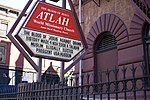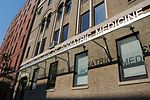Marcus Garvey Park

Marcus Garvey Park (formerly and also named Mount Morris Park) is a 20.16-acre (81,600 m2) park on the border between the Harlem and East Harlem neighborhoods of Manhattan, New York City. The park, centered on a massive and steep outcropping of schist, interrupts the flow of Fifth Avenue traffic, which is routed around the park via Mount Morris Park West. The park is also bounded by 120th Street to the south, 124th Street to the north, and Madison Avenue to the east. The park was created in 1840 and was originally named for Robert Morris, then the mayor of New York City. It was renamed after black activist and businessman Marcus Garvey in 1973. Marcus Garvey Park contains flat lawns and playing fields surrounding the schist outcropping, as well as the Harlem Fire Watchtower, a New York City designated landmark. It is operated and maintained by the New York City Department of Parks and Recreation.
Excerpt from the Wikipedia article Marcus Garvey Park (License: CC BY-SA 3.0, Authors, Images).Marcus Garvey Park
East 122nd Street, New York Manhattan
Geographical coordinates (GPS) Address Nearby Places Show on map
Geographical coordinates (GPS)
| Latitude | Longitude |
|---|---|
| N 40.804487 ° | E -73.943696 ° |
Address
Harlem Fire Watchtower
East 122nd Street
10037 New York, Manhattan
New York, United States
Open on Google Maps







